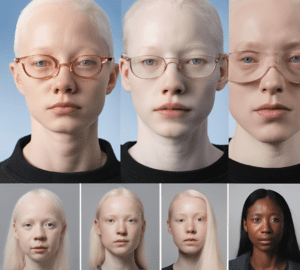Introduction
The combination of albinism and Down syndrome in any individual represents a unique set of challenges that require deep understanding and special consideration. When these two conditions co-occur in an albino black person with Down syndrome, the complexity increases. Both albinism and Down syndrome affect individuals in different ways, and when combined, their effects on physical health, cognitive development, and social experiences can create significant hurdles.
This article explores the intersection of albinism and albino black persons with down syndrome, shedding light on how these conditions interact, their implications for daily life, and ways to improve quality of life through informed care. We’ll also explore the broader landscape of albinism and its types, as well as the specific needs of individuals living with both conditions.
What Are the 7 Types of Albinism?
Before diving deeper into the challenges faced by albino black persons with Down syndrome, it’s important to understand the 7 types of albinism. Each type has distinct genetic causes and varying degrees of visual and physical impairments. Knowing the type of albinism can significantly influence how one approaches treatment and support.
Oculocutaneous Albinism (OCA) Type 1: This is the most severe form of albinism, where there is a complete absence of melanin in the skin, hair, and eyes. Individuals with OCA1 experience significant vision problems, including nystagmus (involuntary eye movements), poor visual acuity, and light sensitivity.
Oculocutaneous Albinism (OCA) Type 2: More common in individuals of African descent, OCA2 leads to lighter skin, hair, and eyes but with milder visual issues compared to OCA1. It is the most common form of albinism in albino black persons.
Oculocutaneous Albinism (OCA) Type 3: Known as ruby albinism, this type results in copper-colored or red hair along with fair skin. While vision impairments exist, they are generally less severe than OCA1.
Oculocutaneous Albinism (OCA) Type 4: This is a milder form of albinism that results in light skin and hair, with only minimal vision impairments. It is considered one of the least severe forms of albinism.
X-linked Albinism (XLA): This type primarily affects males and results in a total lack of pigmentation in the skin, hair, and eyes, similar to OCA1. The vision problems associated with XLA are often profound.
Hermansky-Pudlak Syndrome (HPS): In addition to albinism, HPS is associated with bleeding disorders and lung diseases. It is a rarer and more complex form of albinism, requiring attention to multiple health issues.
Chediak-Higashi Syndrome (CHS): This form of albinism not only affects pigmentation and vision but also impairs the immune system, making individuals more susceptible to infections.
For albino black persons with Down syndrome, OCA2 is the most likely form of albinism, although other types can occur depending on genetics. Knowing which form of albinism is present is essential for creating an effective care plan.
Does Albinism Affect the Brain?
One of the most common questions that arise when discussing albinism is whether it directly impacts the brain. In general, albinism does not affect cognitive function. It is primarily a condition that affects pigmentation in the skin, eyes, and hair, as well as visual processing. However, the visual impairments caused by albinism can indirectly affect learning and cognitive development, especially when compounded with the developmental challenges associated with Down syndrome.
In individuals with Down syndrome, cognitive delays are typically observed in areas such as speech, motor skills, and overall learning abilities. When albinism is present, the resulting vision impairments—such as nystagmus, photophobia (light sensitivity), and astigmatism—make it even more difficult for individuals to engage in visual learning. As vision plays a crucial role in learning, children with both Down syndrome and albinism might find it harder to absorb information through conventional means like reading or observing their environment.

The Impact of Vision on Cognitive Development
An essential component of learning is vision. For children with albinism, visual difficulties are significant. But for albino black persons with Down syndrome, the vision problems associated with albinism compound the cognitive delays caused by Down syndrome. This can result in a range of developmental delays, such as:
Delayed Speech Development: Since children with Down syndrome already face challenges in language development, the added difficulty of visual impairments can delay speech acquisition further. Difficulty seeing words, facial expressions, and visual cues may limit their ability to communicate effectively.
Motor Skills and Coordination Issues: The lack of visual clarity can make it difficult for children to perform tasks that require visual tracking and hand-eye coordination. Activities such as writing, drawing, and even walking might take longer to master.
Delayed Social Skills: Children with Down syndrome often struggle with social interactions, and albinism can add an additional layer of complexity. People with albinism often face social stigma due to their appearance, which may result in a sense of isolation or low self-esteem.
How to Support Albino Black Persons with Down Syndrome
Supporting albino black persons with Down syndrome requires a comprehensive, individualized approach that addresses both vision problems and cognitive delays. Here are several ways caregivers, healthcare providers, and educators can help these individuals thrive:
1. Early Intervention and Specialized Education Plans
As with any developmental delay, early intervention is key. The earlier children with Down syndrome and albinism receive the support they need, the better their long-term outcomes. Specialized educational plans should include modifications to traditional learning tools to account for the vision issues caused by albinism.
For example, large print books, audio books, and screen readers can help children with albinism absorb educational content despite their vision challenges. Tactile learning methods, such as using raised-line paper for writing or using objects that they can touch to understand concepts, can also help them learn.
2. Vision Therapy and Regular Eye Exams
Regular eye exams are critical for individuals with albinism, especially those who have additional cognitive delays. Vision therapy can assist in improving the ability to track and focus on visual stimuli, even if it doesn’t restore full visual clarity. For children with albinism and Down syndrome, therapy can help them adapt to their vision challenges and improve their overall engagement with the world.
3. Social and Emotional Support
Children with albinism often face social stigma due to their appearance, which can be further complicated by the challenges of Down syndrome. Albino black persons with down syndrome may feel out of place, leading to social isolation or emotional difficulties. Caregivers should encourage positive social interactions and ensure that children feel supported and accepted by peers and adults alike.
Promoting self-esteem and confidence is vital. Offering reassurance and helping these children develop healthy coping mechanisms can greatly improve their emotional well-being.
4. Sun Protection and Skin Care
People with albinism lack melanin, which makes their skin more susceptible to sun damage and skin cancer. For albino black persons with Down syndrome, this risk is heightened because cognitive delays may limit their understanding of the importance of sun protection. Caregivers must ensure these individuals wear sunscreen, protective clothing, and hats when outdoors.
Regular skin checks are also necessary to detect any early signs of skin damage. Preventative care can go a long way in ensuring long-term health.

5. Multidisciplinary Care
An effective care plan for albino black persons with Down syndrome requires a multidisciplinary approach that includes pediatricians, ophthalmologists, speech therapists, physical therapists, and special education teachers. These professionals must work together to develop an integrated plan that addresses both the visual impairments caused by albinism and the developmental delays associated with Down syndrome.
Conclusion
In conclusion, albino black persons with Down syndrome face a unique set of challenges that require a thoughtful, personalized approach to care. The combination of albinism and Down syndrome affects multiple aspects of life, including vision, cognitive development, and social interactions. However, with early intervention, specialized therapies, and a supportive environment, these individuals can lead fulfilling, meaningful lives.
By focusing on both the vision problems caused by albinism and the cognitive delays of Down syndrome, caregivers and educators can help albino black persons reach their full potential. Early intervention, personalized education, and ongoing support are key to ensuring that individuals with these dual conditions can thrive.
The journey may be difficult, but with compassion, understanding, and a comprehensive approach, individuals with albinism and albino black persons with Down syndrome can overcome obstacles and achieve success in ways that are uniquely their own.


